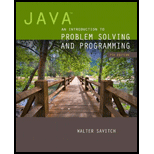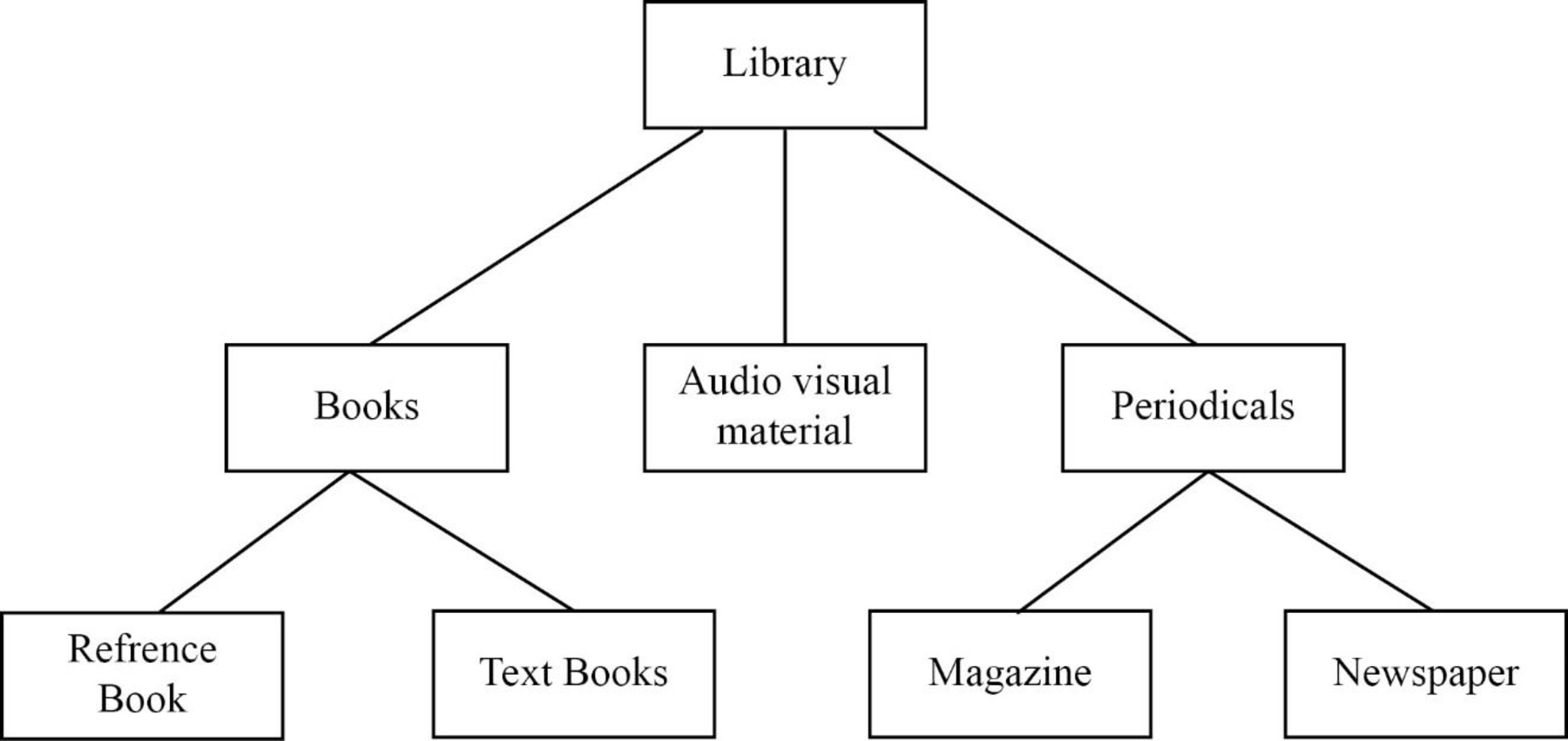
Java: An Introduction to Problem Solving and Programming (7th Edition)
7th Edition
ISBN: 9780133766264
Author: Walter Savitch
Publisher: PEARSON
expand_more
expand_more
format_list_bulleted
Concept explainers
Textbook Question
Chapter 8, Problem 1E
Consider a program that will keep track of the items in a school’s library. Draw a class hierarchy, including a base class, for the different kinds of items. Be sure to also consider items that cannot be checked out.
Expert Solution & Answer
Explanation of Solution
Class hierarchy for school library:

- In the above diagram, “Library” is the base class, “Book”, “Audio visual material”, and “Periodicals” are the derived classes of the “Library”.
- The “Reference Book”, and “Text Books” are the derived classes of the “Book” class.
- The “Magazine”, and “Newspaper” are the derived classes of the “Periodicals” class.
- Here, every book must be checked out.
Want to see more full solutions like this?
Subscribe now to access step-by-step solutions to millions of textbook problems written by subject matter experts!
Students have asked these similar questions
solve this questions for me .
a) first player is the minimizing player. What move should be chosen?b) What nodes would not need to be examined using the alpha-beta pruning procedure?
Consider the problem of finding a path in the grid shown below from the position S to theposition G. The agent can move on the grid horizontally and vertically, one square at atime (each step has a cost of one). No step may be made into a forbidden crossed area. Inthe case of ties, break it using up, left, right, and down.(a) Draw the search tree in a greedy search. Manhattan distance should be used as theheuristic function. That is, h(n) for any node n is the Manhattan distance from nto G. The Manhattan distance between two points is the distance in the x-directionplus the distance in the y-direction. It corresponds to the distance traveled along citystreets arranged in a grid. For example, the Manhattan distance between G and S is4. What is the path that is found by the greedy search?(b) Draw the search tree in an A∗search. Manhattan distance should be used as the
Chapter 8 Solutions
Java: An Introduction to Problem Solving and Programming (7th Edition)
Ch. 8.1 - Prob. 1STQCh. 8.1 - Suppose the class SportsCar is a derived class of...Ch. 8.1 - Suppose the class SportsCar is a derived class of...Ch. 8.1 - Can a derived class directly access by name a...Ch. 8.1 - Can a derived class directly invoke a private...Ch. 8.1 - Prob. 6STQCh. 8.1 - Suppose s is an object of the class Student. Base...Ch. 8.2 - Give a complete definition of a class called...Ch. 8.2 - Add a constructor to the class Student that sets...Ch. 8.2 - Rewrite the definition of the method writeoutput...
Ch. 8.2 - Rewrite the definition of the method reset for the...Ch. 8.2 - Can an object be referenced by variables of...Ch. 8.2 - What is the type or types of the variable(s) that...Ch. 8.2 - Prob. 14STQCh. 8.2 - Prob. 15STQCh. 8.2 - Consider the code below, which was discussed in...Ch. 8.2 - Prob. 17STQCh. 8.3 - Prob. 18STQCh. 8.3 - Prob. 19STQCh. 8.3 - Is overloading a method name an example of...Ch. 8.3 - In the following code, will the two invocations of...Ch. 8.3 - In the following code, which definition of...Ch. 8.4 - Prob. 23STQCh. 8.4 - Prob. 24STQCh. 8.4 - Prob. 25STQCh. 8.4 - Prob. 26STQCh. 8.4 - Prob. 27STQCh. 8.4 - Prob. 28STQCh. 8.4 - Are the two definitions of the constructors given...Ch. 8.4 - The private method skipSpaces appears in the...Ch. 8.4 - Describe the implementation of the method drawHere...Ch. 8.4 - Is the following valid if ShapeBaSe is defined as...Ch. 8.4 - Prob. 33STQCh. 8.5 - Prob. 34STQCh. 8.5 - What is the difference between what you can do in...Ch. 8.5 - Prob. 36STQCh. 8 - Consider a program that will keep track of the...Ch. 8 - Implement your base class for the hierarchy from...Ch. 8 - Draw a hierarchy for the components you might find...Ch. 8 - Suppose we want to implement a drawing program...Ch. 8 - Create a class Square derived from DrawableShape,...Ch. 8 - Create a class SchoolKid that is the base class...Ch. 8 - Derive a class ExaggeratingKid from SchoolKid, as...Ch. 8 - Create an abstract class PayCalculator that has an...Ch. 8 - Derive a class RegularPay from PayCalculator, as...Ch. 8 - Create an abstract class DiscountPolicy. It should...Ch. 8 - Derive a class BulkDiscount from DiscountPolicy,...Ch. 8 - Derive a class BuyNItemsGetOneFree from...Ch. 8 - Prob. 13ECh. 8 - Prob. 14ECh. 8 - Create an interface MessageEncoder that has a...Ch. 8 - Create a class SubstitutionCipher that implements...Ch. 8 - Create a class ShuffleCipher that implements the...Ch. 8 - Define a class named Employee whose objects are...Ch. 8 - Define a class named Doctor whose objects are...Ch. 8 - Create a base class called Vehicle that has the...Ch. 8 - Create a new class called Dog that is derived from...Ch. 8 - Define a class called Diamond that is derived from...Ch. 8 - Prob. 2PPCh. 8 - Prob. 3PPCh. 8 - Prob. 4PPCh. 8 - Create an interface MessageDecoder that has a...Ch. 8 - For this Programming Project, start with...Ch. 8 - Modify the Student class in Listing 8.2 so that it...Ch. 8 - Prob. 8PPCh. 8 - Prob. 9PPCh. 8 - Prob. 10PP
Additional Engineering Textbook Solutions
Find more solutions based on key concepts
What is the difference between machine language code and byte code?
Starting Out with Java: From Control Structures through Objects (7th Edition) (What's New in Computer Science)
Explain how entities are transformed into tables.
Database Concepts (8th Edition)
List the five major hardware components of a computer system.
Starting Out with Java: From Control Structures through Data Structures (4th Edition) (What's New in Computer Science)
Blocks A, B, and C have weights of 50 N, 25 N, and 15 N, respectively. Determine the smallest horizontal force ...
INTERNATIONAL EDITION---Engineering Mechanics: Statics, 14th edition (SI unit)
To calculate the total number of iterations of a nested loop, add the number of iterations of all the loops.
Starting Out with Python (4th Edition)
How is the hydrodynamic entry length defined for flow in a pipe? Is the entry length longer in laminar or turbu...
Fluid Mechanics: Fundamentals and Applications
Knowledge Booster
Learn more about
Need a deep-dive on the concept behind this application? Look no further. Learn more about this topic, computer-science and related others by exploring similar questions and additional content below.Similar questions
- whats for dinner? pleasearrow_forwardConsider the follow program that prints a page number on the left or right side of a page. Define and use a new function, isEven, that returns a Boolean to make the condition in the if statement easier to understand. ef main() : page = int(input("Enter page number: ")) if page % 2 == 0 : print(page) else : print("%60d" % page) main()arrow_forwardWhat is the correct python code for the function def countWords(string) that will return a count of all the words in the string string of workds that are separated by spaces.arrow_forward
- Consider the following program that counts the number of spaces in a user-supplied string. Modify the program to define and use a function, countSpaces, instead. def main() : userInput = input("Enter a string: ") spaces = 0 for char in userInput : if char == " " : spaces = spaces + 1 print(spaces) main()arrow_forwardWhat is the python code for the function def readFloat(prompt) that displays the prompt string, followed by a space, reads a floating-point number in, and returns it. Here is a typical usage: salary = readFloat("Please enter your salary:") percentageRaise = readFloat("What percentage raise would you like?")arrow_forwardassume python does not define count method that can be applied to a string to determine the number of occurances of a character within a string. Implement the function numChars that takes a string and a character as arguments and determined and returns how many occurances of the given character occur withing the given stringarrow_forward
- Consider the ER diagram of online sales system above. Based on the diagram answer the questions below, a) Based on the ER Diagram, determine the Foreign Key in the Product Table. Just mention the name of the attribute that could be the Foreign Key. b) Mention the relationship between the Order and Customer Entities. You can use the following: 1:1, 1:M, M:1, 0:1, 1:0, M:0, 0:M c) Is there a direct relationship that exists between Store and Customer entities? Answer Yes/No? d) Which of the 4 Entities mention in the diagram can have a recursive relationship? e) If a new entity Order_Details is introduced, will it be a strong entity or weak entity? If it is a weak entity, then mention its type?arrow_forwardNo aiarrow_forwardGiven the dependency diagram of attributes {C1,C2,C3,C4,C5) in a table shown in the following figure, (the primary key attributes are underlined)arrow_forward
- What are 3 design techniques that enable data representations to be effective and engaging? What are some usability considerations when designing data representations? Provide examples or use cases from your professional experience.arrow_forward2D array, Passing Arrays to Methods, Returning an Array from a Method (Ch8) 2. Read-And-Analyze: Given the code below, answer the following questions. 2 1 import java.util.Scanner; 3 public class Array2DPractice { 4 5 6 7 8 9 10 11 12 13 14 15 16 public static void main(String args[]) { 17 } 18 // Get an array from the user int[][] m = getArray(); // Display array elements System.out.println("You provided the following array "+ java.util.Arrays.deepToString(m)); // Display array characteristics int[] r = findCharacteristics(m); System.out.println("The minimum value is: " + r[0]); System.out.println("The maximum value is: " + r[1]); System.out.println("The average is: " + r[2] * 1.0/(m.length * m[0].length)); 19 // Create an array from user input public static int[][] getArray() { 20 21 PASSTR2222322222222222 222323 F F F F 44 // Create a Scanner to read user input Scanner input = new Scanner(System.in); // Ask user to input a number, and grab that number with the Scanner…arrow_forwardGiven the dependency diagram of attributes C1,C2,C3,C4,C5 in a table shown in the following figure, the primary key attributes are underlined Make a database with multiple tables from attributes as shown above that are in 3NF, showing PK, non-key attributes, and FK for each table? Assume the tables are already in 1NF. Hint: 3 tables will result after deducing 1NF -> 2NF -> 3NFarrow_forward
arrow_back_ios
SEE MORE QUESTIONS
arrow_forward_ios
Recommended textbooks for you
 C++ for Engineers and ScientistsComputer ScienceISBN:9781133187844Author:Bronson, Gary J.Publisher:Course Technology Ptr
C++ for Engineers and ScientistsComputer ScienceISBN:9781133187844Author:Bronson, Gary J.Publisher:Course Technology Ptr C++ Programming: From Problem Analysis to Program...Computer ScienceISBN:9781337102087Author:D. S. MalikPublisher:Cengage Learning
C++ Programming: From Problem Analysis to Program...Computer ScienceISBN:9781337102087Author:D. S. MalikPublisher:Cengage Learning EBK JAVA PROGRAMMINGComputer ScienceISBN:9781337671385Author:FARRELLPublisher:CENGAGE LEARNING - CONSIGNMENT
EBK JAVA PROGRAMMINGComputer ScienceISBN:9781337671385Author:FARRELLPublisher:CENGAGE LEARNING - CONSIGNMENT- Programming Logic & Design ComprehensiveComputer ScienceISBN:9781337669405Author:FARRELLPublisher:Cengage
 Microsoft Visual C#Computer ScienceISBN:9781337102100Author:Joyce, Farrell.Publisher:Cengage Learning,
Microsoft Visual C#Computer ScienceISBN:9781337102100Author:Joyce, Farrell.Publisher:Cengage Learning, Programming with Microsoft Visual Basic 2017Computer ScienceISBN:9781337102124Author:Diane ZakPublisher:Cengage Learning
Programming with Microsoft Visual Basic 2017Computer ScienceISBN:9781337102124Author:Diane ZakPublisher:Cengage Learning

C++ for Engineers and Scientists
Computer Science
ISBN:9781133187844
Author:Bronson, Gary J.
Publisher:Course Technology Ptr

C++ Programming: From Problem Analysis to Program...
Computer Science
ISBN:9781337102087
Author:D. S. Malik
Publisher:Cengage Learning

EBK JAVA PROGRAMMING
Computer Science
ISBN:9781337671385
Author:FARRELL
Publisher:CENGAGE LEARNING - CONSIGNMENT

Programming Logic & Design Comprehensive
Computer Science
ISBN:9781337669405
Author:FARRELL
Publisher:Cengage

Microsoft Visual C#
Computer Science
ISBN:9781337102100
Author:Joyce, Farrell.
Publisher:Cengage Learning,

Programming with Microsoft Visual Basic 2017
Computer Science
ISBN:9781337102124
Author:Diane Zak
Publisher:Cengage Learning
Java Math Library; Author: Alex Lee;https://www.youtube.com/watch?v=ufegX5o8uc4;License: Standard YouTube License, CC-BY